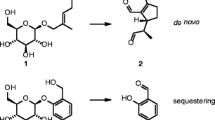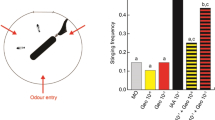Abstract
Steroidal glycoalkaloids, found in species of the Solanaceae, elicit bursting activity in galeal and tarsal chemosensilla of adult Colorado potato beetles. The effect has an average latency of 6–12 sec, depending on the sensillum/alkaloid combination. A 20-sec alkaloid treatment is often suffficient to render galeal sensilla unresponsive to gamma-aminobutyric acid, normally an effective stimulant. The alkaloids have similar effects on galeal sensilla of larval Colorado potato beetles and on labellar chemosensilla of the blowfly. It is concluded that these compounds act independently of any specialized chemoreceptor in the Colorado potato beetle, and that association of the Colorado potato beetle with solanaceous plants has not led to evolution of a specific receptor forSolanum glycoalkaloids.
Similar content being viewed by others
References
Bongers, W. 1970. Aspects of host-plant relationship of the Colorado beetle.Meded. Landbouwhogesch.Wageningen, 77 pp.
Gregory, P., Sinden, S.L., Osman, S.F., andTingey, W.M. 1981. Glycoalkaloids of wild, tuber-bearingSolarium species.Agric. Food Chem. 29:1212–1215.
Heftmann, E. 1967. Biochemistry of steroidal saponins and glycoalkaloids.Lloydia 30:209–222.
Heftmann, E. 1973. Steroids, pp. 171–226,in L.P. Miller (ed.). Phytochemistry, Vol. 2. van Nostrand Reinhold, New York.
Hsiao, T. 1974. Chemical influence on feeding behaviour ofLeptinotarsa beetles, pp. 239–248,in L. Barton Browne (ed.). Experimental Analysis of Insect Behaviour. Springer-Verlag, Berlin.
Hsiao, T., andFraenkel, G. 1968. Selection and specificity of the Colorado potato beetle for solanaceous and non-solanaceous plants.Ann. Entomol. Soc. Amer. 61:493–503.
Levin, D.A. 1976. Alkaloid bearing plants: An ecogeographic perspective.Am. Nat. 110:261–284.
Levinson, H.Z. 1976. The defensive role of alkaloids in insects and plants.Experientia 32:408–411.
Mitchell, B.K., andHarrison, G. 1984. Characterization of galeal chemosensilla in the adult Colorado beetle,Leptinotarsa decemlineata.Physiol. Entomol. 9:49–56.
Mitchell, B.K., andSchoonhoven, L.M. 1974. Taste receptors in Colorado beetle larvae.J. Insect. Physiol. 20:1787–1793.
Mitchell, B.K., andSutcliffe, J.F. 1983. Sensory inhibition as a mechanism of feeding deterrence by three alkaloids on leaf beetle feeding.Physiol. Entomol. 9:57–64.
Robinson, T. 1974. Metabolism and function of alkaloids in plants.Science 184:430–435.
Schoonhoven, L.M. 1982. Biological aspects of antifeedants.Entomol. Exp. Appl. 31:57–69.
Schreiber, K. 1957. Natürliche pflanzliche Resistenstoffe gegen den Kartoffelkäfer und ihr möglicher Wirkungsmechanismus.Züchter 7:289–299.
Schreiber, K. 1958. Über einige Inhaltsstoffe der Solanaceen und ihre Bedeutung für die Kartoffelkäferresistenz.Entomol. Exp. Appl. 1:28–37.
Schreiber, K. 1979. The steroidal alkaloids ofSolanum, pp. 193–202,in J.G. Hawkes, R.N. Lester, and A.D. Skelding (eds.). The Biology and Taxonomy of the Solanaceae. Academic Press, New York.
Segal, R., Shatkovsky, P., andMilo-Goldzweig, I. 1974. On the mechanism of saponin hemolysis—I. hydrolysis of the glycosidic bond.Biochem. Pharmcol. 23:973–981.
Sinden, S.L., Schalk, J.M., andStoner, A.K. 1978. Effects of daylength and maturity of tomato plants on tomatine content and resistance to the Colorado potato beetle.J. Am. Soc. Hortic. Sci. 103:596–600.
Sinden, S.L., Sanford, L.L., andOsman, S.F. 1980. Glycoalkaloids and resistance to the Colorado potato beetle inSolanum chacoense Bitter.Am. Potato J. 57:331–343.
Städler, E. 1984. Contact Chemoreception, pp. 3–35,in W.J. Bell and R.T. Cardé (eds.). Chemical Ecology of Insects. Sinauer Assoc., Sunderland, Massachusetts.
Stürckow, B. 1959. Über den Geschmackssinn und den Tastsinn vonLeptinotarsa decemlineata Say (Chrysomelidae)Z. Vergl. Physiol. 42:255–302.
Stürckow, B., andLöw, I. 1961. Die Wirkung einiger Solanum—Alkaloidglykoside auf den Kartoffelkäfer,Leptinotarsa decemlineata Say.Entomol. Exp. Appl. 4:133–142.
Sutcliffe, J.F., andMitchell, B.K. 1982. Characterization of galeal sugar and glucosinolate-sensitive cells inEntomoscelis americana adults.J. Comp. Physiol. 143:393–399.
Tower, W.L. 1918. The Mechanism of Evolution inLeptinotarsa. Carnegie Institution of Washington, publication No. 263, 384 pp.
Author information
Authors and Affiliations
Rights and permissions
About this article
Cite this article
Mitchell, B.K., Harrison, G.D. Effects ofSolanum glycoalkaloids on chemosensilla in the Colorado potato beetle. J Chem Ecol 11, 73–83 (1985). https://doi.org/10.1007/BF00987607
Received:
Revised:
Issue Date:
DOI: https://doi.org/10.1007/BF00987607




